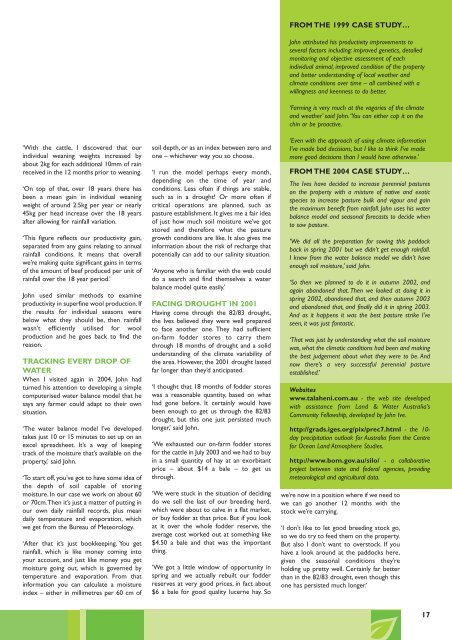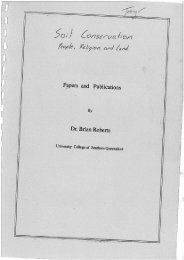Masters of the Climate: Innovative farmers ... - South West NRM
Masters of the Climate: Innovative farmers ... - South West NRM
Masters of the Climate: Innovative farmers ... - South West NRM
Create successful ePaper yourself
Turn your PDF publications into a flip-book with our unique Google optimized e-Paper software.
‘With <strong>the</strong> cattle, I discovered that our<br />
individual weaning weights increased by<br />
about 2kg for each additional 10mm <strong>of</strong> rain<br />
received in <strong>the</strong> 12 months prior to weaning.<br />
‘On top <strong>of</strong> that, over 18 years <strong>the</strong>re has<br />
been a mean gain in individual weaning<br />
weight <strong>of</strong> around 2.5kg per year or nearly<br />
45kg per head increase over <strong>the</strong> 18 years<br />
after allowing for rainfall variation.<br />
‘This figure reflects our productivity gain,<br />
separated from any gains relating to annual<br />
rainfall conditions. It means that overall<br />
we’re making quite significant gains in terms<br />
<strong>of</strong> <strong>the</strong> amount <strong>of</strong> beef produced per unit <strong>of</strong><br />
rainfall over <strong>the</strong> 18 year period.’<br />
John used similar methods to examine<br />
productivity in superfine wool production. If<br />
<strong>the</strong> results for individual seasons were<br />
below what <strong>the</strong>y should be, <strong>the</strong>n rainfall<br />
wasn’t efficiently utilised for wool<br />
production and he goes back to find <strong>the</strong><br />
reason.<br />
TRACKING EVERY DROP OF<br />
WATER<br />
When I visited again in 2004, John had<br />
turned his attention to developing a simple<br />
computerised water balance model that he<br />
says any farmer could adapt to <strong>the</strong>ir own<br />
situation.<br />
‘The water balance model I’ve developed<br />
takes just 10 or 15 minutes to set up on an<br />
excel spreadsheet. It’s a way <strong>of</strong> keeping<br />
track <strong>of</strong> <strong>the</strong> moisture that’s available on <strong>the</strong><br />
property,’ said John.<br />
‘To start <strong>of</strong>f, you’ve got to have some idea <strong>of</strong><br />
<strong>the</strong> depth <strong>of</strong> soil capable <strong>of</strong> storing<br />
moisture. In our case we work on about 60<br />
or 70cm.Then it’s just a matter <strong>of</strong> putting in<br />
our own daily rainfall records, plus mean<br />
daily temperature and evaporation, which<br />
we get from <strong>the</strong> Bureau <strong>of</strong> Meteorology.<br />
‘After that it’s just bookkeeping. You get<br />
rainfall, which is like money coming into<br />
your account, and just like money you get<br />
moisture going out, which is governed by<br />
temperature and evaporation. From that<br />
information you can calculate a moisture<br />
index – ei<strong>the</strong>r in millimetres per 60 cm <strong>of</strong><br />
soil depth, or as an index between zero and<br />
one – whichever way you so choose.<br />
‘I run <strong>the</strong> model perhaps every month,<br />
depending on <strong>the</strong> time <strong>of</strong> year and<br />
conditions. Less <strong>of</strong>ten if things are stable,<br />
such as in a drought! Or more <strong>of</strong>ten if<br />
critical operations are planned, such as<br />
pasture establishment. It gives me a fair idea<br />
<strong>of</strong> just how much soil moisture we’ve got<br />
stored and <strong>the</strong>refore what <strong>the</strong> pasture<br />
growth conditions are like. It also gives me<br />
information about <strong>the</strong> risk <strong>of</strong> recharge that<br />
potentially can add to our salinity situation.<br />
‘Anyone who is familiar with <strong>the</strong> web could<br />
do a search and find <strong>the</strong>mselves a water<br />
balance model quite easily.’<br />
FACING DROUGHT IN 2001<br />
Having come through <strong>the</strong> 82/83 drought,<br />
<strong>the</strong> Ives believed <strong>the</strong>y were well prepared<br />
to face ano<strong>the</strong>r one. They had sufficient<br />
on-farm fodder stores to carry <strong>the</strong>m<br />
through 18 months <strong>of</strong> drought and a solid<br />
understanding <strong>of</strong> <strong>the</strong> climate variability <strong>of</strong><br />
<strong>the</strong> area. However, <strong>the</strong> 2001 drought lasted<br />
far longer than <strong>the</strong>y’d anticipated.<br />
‘I thought that 18 months <strong>of</strong> fodder stores<br />
was a reasonable quantity, based on what<br />
had gone before. It certainly would have<br />
been enough to get us through <strong>the</strong> 82/83<br />
drought, but this one just persisted much<br />
longer,’ said John.<br />
‘We exhausted our on-farm fodder stores<br />
for <strong>the</strong> cattle in July 2003 and we had to buy<br />
in a small quantity <strong>of</strong> hay at an exorbitant<br />
price – about $14 a bale – to get us<br />
through.<br />
‘We were stuck in <strong>the</strong> situation <strong>of</strong> deciding<br />
do we sell <strong>the</strong> last <strong>of</strong> our breeding herd,<br />
which were about to calve in a flat market,<br />
or buy fodder at that price. But if you look<br />
at it over <strong>the</strong> whole fodder reserve, <strong>the</strong><br />
average cost worked out at something like<br />
$4.50 a bale and that was <strong>the</strong> important<br />
thing.<br />
‘We got a little window <strong>of</strong> opportunity in<br />
spring and we actually rebuilt our fodder<br />
reserves at very good prices, in fact about<br />
$6 a bale for good quality lucerne hay. So<br />
FROM THE 1999 CASE STUDY…<br />
John attributed his productivity improvements to<br />
several factors including: improved genetics, detailed<br />
monitoring and objective assessment <strong>of</strong> each<br />
individual animal, improved condition <strong>of</strong> <strong>the</strong> property<br />
and better understanding <strong>of</strong> local wea<strong>the</strong>r and<br />
climate conditions over time – all combined with a<br />
willingness and keenness to do better.<br />
‘Farming is very much at <strong>the</strong> vagaries <strong>of</strong> <strong>the</strong> climate<br />
and wea<strong>the</strong>r’ said John.‘You can ei<strong>the</strong>r cop it on <strong>the</strong><br />
chin or be proactive.<br />
‘Even with <strong>the</strong> approach <strong>of</strong> using climate information<br />
I’ve made bad decisions, but I like to think I’ve made<br />
more good decisions than I would have o<strong>the</strong>rwise.’<br />
FROM THE 2004 CASE STUDY…<br />
The Ives have decided to increase perennial pastures<br />
on <strong>the</strong> property with a mixture <strong>of</strong> native and exotic<br />
species to increase pasture bulk and vigour and gain<br />
<strong>the</strong> maximum benefit from rainfall. John uses his water<br />
balance model and seasonal forecasts to decide when<br />
to sow pasture.<br />
‘We did all <strong>the</strong> preparation for sowing this paddock<br />
back in spring 2001 but we didn’t get enough rainfall.<br />
I knew from <strong>the</strong> water balance model we didn’t have<br />
enough soil moisture,’ said John.<br />
‘So <strong>the</strong>n we planned to do it in autumn 2002, and<br />
again abandoned that. Then we looked at doing it in<br />
spring 2002, abandoned that, and <strong>the</strong>n autumn 2003<br />
and abandoned that, and finally did it in spring 2003.<br />
And as it happens it was <strong>the</strong> best pasture strike I’ve<br />
seen, it was just fantastic.<br />
‘That was just by understanding what <strong>the</strong> soil moisture<br />
was, what <strong>the</strong> climatic conditions had been and making<br />
<strong>the</strong> best judgement about what <strong>the</strong>y were to be. And<br />
now <strong>the</strong>re’s a very successful perennial pasture<br />
established.’<br />
Websites<br />
www.talaheni.com.au - <strong>the</strong> web site developed<br />
with assistance from Land & Water Australia’s<br />
Community Fellowship, developed by John Ive.<br />
http://grads.iges.org/pix/prec7.html - <strong>the</strong> 10-<br />
day precipitation outlook for Australia from <strong>the</strong> Centre<br />
for Ocean Land Atmosphere Studies.<br />
http://www.bom.gov.au/silo/ - a collaborative<br />
project between state and federal agencies, providing<br />
meteorological and agricultural data.<br />
we’re now in a position where if we need to<br />
we can go ano<strong>the</strong>r 12 months with <strong>the</strong><br />
stock we’re carrying.<br />
‘I don’t like to let good breeding stock go,<br />
so we do try to feed <strong>the</strong>m on <strong>the</strong> property.<br />
But also I don’t want to overstock. If you<br />
have a look around at <strong>the</strong> paddocks here,<br />
given <strong>the</strong> seasonal conditions <strong>the</strong>y’re<br />
holding up pretty well. Certainly far better<br />
than in <strong>the</strong> 82/83 drought, even though this<br />
one has persisted much longer.’<br />
17
















